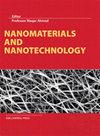Formation of oxide crystallites on the porous GaAs surface by electrochemical deposition
IF 3.3
3区 材料科学
Q2 MATERIALS SCIENCE, MULTIDISCIPLINARY
引用次数: 7
Abstract
We demonstrate how the formation of octahedral microcrystals of arsenic oxide As2O3 in the form of arsenolite with a size of 200 nm to 10 μm can be initiated by the electrochemical etching method with simultaneous deposition on the surface of substrates with n-GaAs (111). Crystallites were formed on a previously synthesized porous layer of GaAs. To explain the behavior of formation on the surface of the monocrystalline GaAs porous layer and As2O3 crystallites in the electrochemical reaction, we propose a qualitative model based on the decomposition of binary semiconductors in contact with electrolytes. Under this model, the crystallization of precipitated oxides occurs as a result of the transfer of ions to the crystal surface as a result of the electrolysis process. The formation of the composite structure takes place on the surface of the semiconductor and is characterized by the minimization of elastic energy. XRD analysis showed the formation of a complex compound of As2O3 and As0.172Sb0.570O1.113. The appearance of antimony is explained in terms of the formation of new centers when the As atom is replaced by an Sb doping atom in the crystal. Directed controlled oxidation technologies make it possible to synthesize a reliable passivating layer consisting of one type of oxide, namely As2O3 in the cubic phase of arsenolite. In addition, such structures can be used in photonics devices and as photocatalysts.电化学沉积在多孔GaAs表面形成氧化物微晶
我们演示了如何通过电化学蚀刻方法在衬底表面同时沉积n-GaAs(111),以砷石的形式形成尺寸为200 nm至10μm的氧化砷As2O3的八面体微晶。晶体是在先前合成的GaAs多孔层上形成的。为了解释电化学反应中单晶GaAs多孔层和As2O3晶粒表面的形成行为,我们提出了一个基于与电解质接触的二元半导体分解的定性模型。在该模型下,沉淀氧化物的结晶是由于电解过程中离子转移到晶体表面的结果。复合结构的形成发生在半导体的表面上,其特征在于弹性能的最小化。XRD分析显示形成了As2O3和As0.172Sb0.570O1.113的络合物。锑的出现是根据晶体中As原子被Sb掺杂原子取代时新中心的形成来解释的。定向控制氧化技术使合成一种可靠的钝化层成为可能,该钝化层由一种类型的氧化物组成,即砷石立方相中的As2O3。此外,这种结构可以用于光子学器件和作为光催化剂。
本文章由计算机程序翻译,如有差异,请以英文原文为准。
求助全文
约1分钟内获得全文
求助全文
来源期刊

Nanomaterials and Nanotechnology
NANOSCIENCE & NANOTECHNOLOGY-MATERIALS SCIENCE, MULTIDISCIPLINARY
CiteScore
7.20
自引率
21.60%
发文量
13
审稿时长
15 weeks
期刊介绍:
Nanomaterials and Nanotechnology is a JCR ranked, peer-reviewed open access journal addressed to a cross-disciplinary readership including scientists, researchers and professionals in both academia and industry with an interest in nanoscience and nanotechnology. The scope comprises (but is not limited to) the fundamental aspects and applications of nanoscience and nanotechnology
 求助内容:
求助内容: 应助结果提醒方式:
应助结果提醒方式:


